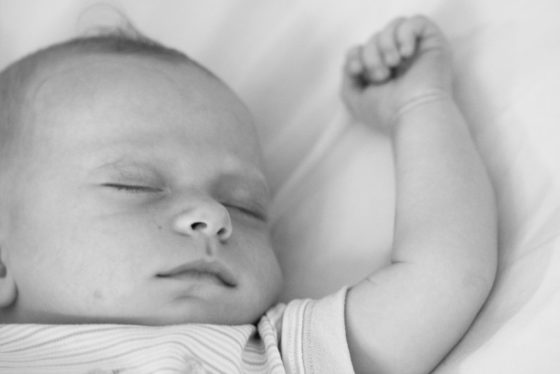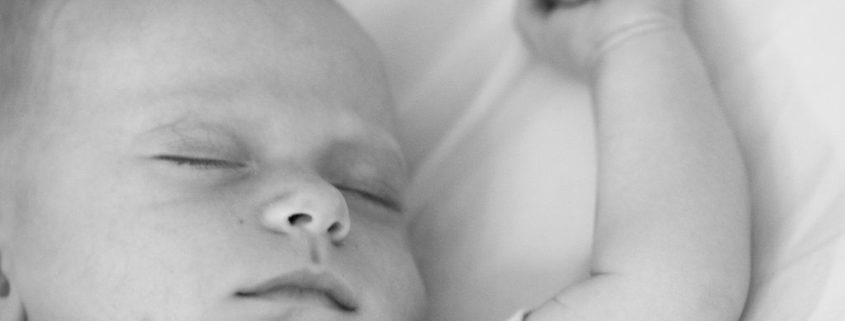Cribs vs. Co-Sleeping: Where Will Your Baby Sleep?

Contents
Bed-Sharing
Bed-sharing is one type of co-sleeping (sleeping close enough to your baby to be able to see, smell, or touch each other). Bed-sharing means just what it sounds like – having your new baby sleep in your bed.
Bed-Sharing Pros
Some studies show that bed-sharing can make nighttime feedings easier and can help the mother’s sleep cycle sync up with the baby’s. It may also help babies fall asleep more easily and sleep for more of the night, since feeding times are shorter. Plus, parents may enjoy the bonding time after being separated from their little one all day at work.
In addition, some studies have found that SIDS (sudden infant death syndrome) is less common in places where co-sleeping is the norm. Some research suggests that SIDS is caused by a baby’s inability to wake up when they have trouble breathing at night. As the baby’s sleep cycles sync with the mother’s, that risk may be reduced.
Bed-Sharing Cons
On the flip side, some studies have shown that bed-sharing is one of the top causes of death for infants under 3 months old. Opponents of bed-sharing point to the risk that the child will get caught in bedding, pillows, or gaps between the mattress and headboard or that a parent will roll over onto the child. Babies may also be at risk for rolling off the bed.
Some people also argue that the baby gets used to sleeping only with the parents, making it harder to go down for a nap. Some children may also have a hard time adjusting when it’s time to move to a crib – experts recommend starting that process before 6 months of age because after that, the baby’s sleep patterns are ingrained and separation anxiety can be an issue. In addition, bed-sharing may affect your ability to sleep at night.
For these safety reasons, the American Academy of Pediatricians has recommended against bed-sharing.
Bed-Sharing Safety Tips
The evidence on bed-sharing is mixed; some studies say it’s more dangerous and others say it’s safer. There’s just no good answer. If you do decide that bed-sharing is right for you and your little one, you should always take these safety precautions:
- Sleep in as large a bed as possible so you have plenty of room
- Make sure there are no gaps between your mattress and headboard or wall that the baby could fall into
- Consider adding a guardrail to prevent your little one from rolling off the bed
- Keep pillows and blankets away from your little one; babies can easily get caught and suffocate in them
- Sleep on a firm mattress; babies may suffocate if they end up sleeping facedown on a soft surface
- Do not let other children sleep in the bed; they may not be as aware of the baby’s presence and are more likely to roll over onto the baby
- Do not smoke and do not bed-share if you’ve been drinking or if you’ve taken drugs or medication that make you drowsy; you may be more likely to roll onto the baby and less likely to be able to react to the baby’s needs
Room-Sharing
Room-sharing is another type of co-sleeping, where the baby sleeps in a crib or bassinet attached to your bed or in your room.
Room-Sharing Pros
Evidence suggests that sleeping in the same room as the mother decreases a baby’s risk of SIDS. It offers the benefits of easier feedings and lets you keep a close eye on your baby, but without the risk that someone will roll onto the baby or that the baby will suffocate or get trapped in the bedding.
There are even co-sleeping cribs and bassinets designed to attach to the side of your bed so that your child is right next to you, but you can’t roll over onto them.
Room-Sharing Cons
Room-sharing is considered quite safe, but some parents don’t feel like it gets them close enough to their new little ones. In addition, the amount of room available may be a concern. It’s easy to fit a crib into a big master bedroom in a ranch house, but much harder to find that kind of space in a tiny Manhattan apartment!
And like bed-sharing, room-sharing means you run the risk of disturbing the baby if you want to go to bed later or get up earlier than your little one.
Room-Sharing Safety Tips
If you’re using a regular crib or bassinet in the room, just be sure to choose one that is designed for safety – no gaps, a well-fitting mattress, and no blankets, pillows, or toys. If you want to use one that attaches to your bed, the same applies – make sure there’s no suffocation risk. You’ll also want to consider the placement of the crib or bassinet to make sure you’re not likely to kick it or trip on it if you need to get up for a late-night bathroom trip or a midnight snack.
Crib-Sleeping
The alternative to co-sleeping is crib-sleeping, where the baby sleeps in a crib in another room.
Crib-Sleeping Pros
Crib-sleeping avoids the risks of bed-sharing and gives everyone a little bit more space. Parents don’t have to worry about disturbing the baby by snoring or getting up in the middle of the night. You also don’t have to go to bed when your baby does, which may make it easier to set up a bedtime routine.
You can specifically choose cribs that are designed to be extremely safe, without the risk of the baby getting caught in a crack or getting their head or limbs stuck in a gap. The risk of suffocation is also lower when the baby is in the crib without pillows, blankets, toys, or anything else they can bury their faces in.
Crib-Sleeping Cons
Some parents find that it’s very difficult to get their babies to sleep in a crib. Babies like the safe sensation of being near the warmth and smell of their parents and may become anxious when left alone in a crib. Having the baby in another room can also make feedings more of a chore as someone has to actually get out of bed to manage it.
Some parents also worry that they’re not able to closely monitor their baby during the night. Bed-sharing and room-sharing may make it easier to pick up signs that your little one is in distress. Baby monitors can help, but parents are very closely attuned to their babies and can pick up on signals the monitor won’t.
Crib Sleeping Safety
The biggest risks with crib sleeping are that the child will get roll into a gap, get a head or limb stuck in a gap, or suffocate. You can decrease these risks by finding a crib that won’t allow the baby’s limbs or head through the rail or sides. The crib mattress should be thin and should fit exactly in the crib – no gaps and nothing too fluffy – it’s a suffocation risk. There should never be pillows, blankets, or toys in the crib, as a baby can easily roll over onto them or get caught in them and suffocate. Use pajamas to keep your little one comfortable warm.
Lullaby And Good Night
At the end of the day, the right choice will depend on you and your family. You may plan to co-sleep and find that crib sleeping works better for you, or vice versa. Getting your little one to sleep and getting enough sleep yourself is tough enough – you just have to find what fits your lives!
So sleep well, and enjoy your new little one!
Image Credit and License








Leave a Reply
Want to join the discussion?Feel free to contribute!